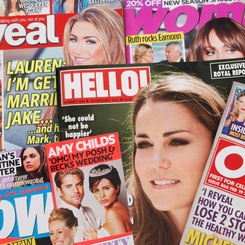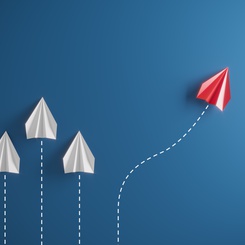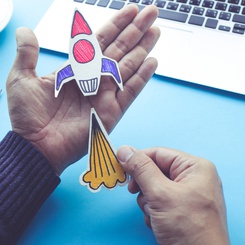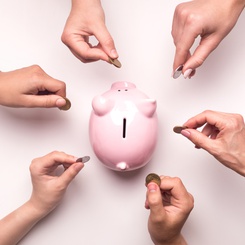With ESSEC Knowledge Editor-in-chief
Brands will take the opportunity to harness the energy around the Paris 2024 Olympic Games. One question is, what is the most effective advertising strategy to achieve this goal? New research from Marc Mazodier, Professor of Marketing and Head of the Marketing Department at ESSEC Business School, and François A. Carrillat (Griffith Business School) and Christine Eckert (UTS Business School, EBS Business School) (1) examines how ads tailored to sporting events impact brand attitudes and choices compared to traditional advertising strategies.
Experts and researchers usually agree that for effective ads, it’s best to be consistent and have ads that align with the product category. Think of car commercials, where the happy customer drives along a scenic road, or banking commercials, where customers look confident in financially safe situations. The superiority of typical advertising over atypical advertising may be surprising if one ignores that most consumers pay little attention to ads. Prior research suggests that our average exposure to digital and outdoor ads is less than 1s (2,3,4). Therefore, ads easily recognizable from brand and product category standpoints perform better on average.
Professor Mazodier and his colleagues discovered that an ad that alludes to an event leaves people feeling more positive towards the brand the ad is about and makes them more likely to purchase the brand than typical ads. This exception to the rule is essential since companies shell out millions of dollars for major sporting events’ primetime slots - and get millions of views in return. Marketers can apply this strategy in the case of the Olympics, using elements of the host city and the Games themselves - like baguettes, berets, and Hausmannian architecture for Paris 2024. This type of advertising may diverge from product category consistency - but can catch viewers’ attention.
The research team compared ads from different categories:
Product-typical ads: these represent the product itself - driving along for a car commercial, for example. This allows consumers to easily recognize what the ad is about. L’Oreal often uses this type of advertising, with good-looking celebrities and a picture of the product.
Event-typical ads: They represent the event, but not the product category. For instance, Air France’s new campaign for the 2024 Paris Olympics shows a woman with the colours of the French flag painted whimsically across her face, as if the flag is blowing in the wind.
Dual-typical ads: They involve elements of both like the last Renault commercial for Roland Garros, which shows tennis players, clay courts, and moving cars.
Atypical ads: Neither event nor product are explicitly indicated, and there are unusual elements—this can help pique the consumer's interest. For instance, Audi showed robbers waiting for their driver who “could not stop driving” instead of a car.
The goal of advertising is to ensure that consumers recognize your offer and to create positive attitudes toward it. Major sporting events - where fans flock to a certain location and spectators at home are glued to the television - provide a unique opportunity to get your ad in front of more people. So how can companies hit a home run? Dr. Mazodier and his colleagues set out to explore which ad type performed best - and why.
Going for marketing gold
To explore which ad type had the biggest impact, the researchers compared these ads in terms of consumer response.
The researchers conducted four field and lab experiments across a total of 32 ads to explore the effects of the type of ad on consumer brand attitude and brand choice, exploring different product categories (cars, food and beverage, skincare) and sporting events (the Olympics, Wimbledon, and FIFA World Cup). With a systematic approach, building sequentially on the results of each study, they looked at how participants (undergraduate students and users of online survey panel companies) responded to ads at different exposure times and the mechanisms driving this effect. A professional graphic designer designed realistic ads for the experiments to ensure that respondents weren’t biased from previous exposure.
Participants were asked about their attitudes toward the brand after seeing the ad, their opinion on the ad itself, and the attributes they linked to the brand.
Surprisingly, it turns out that event-typical ads come out on top, even for very rapid exposures (under 500 ms), and that this is amplified for “longer” exposure times (up to 2 seconds - every bit counts!). While the product-typical ads also performed well after a very brief exposure, event-typical ads led to the best brand evaluations. They resulted in the most positive ad evaluations regardless of the duration of the exposure. Furthermore, dual-typical ads never performed best in any of the four experiments. This is counterintuitive since industry and academic experts thought this ad type yielded good results.
Next, they delved into the “why”: what drove the results? They pinpointed three mechanisms:
-
Knowing what the ad is about: the event-typical ads give enough information to achieve this, even with the rapid exposure.
-
Provoking curiosity: the consumer wants to know more about the ad. Even if the product category isn’t sports-related, they want to know more - what’s linking the product and the event? - and it grabs their attention.
-
Transfer attributes people associate with the event to the brand itself - attributes like popular and iconic, which are associated with the Olympics, can translate to positive feelings about the brand.
These results counter conventional wisdom, which says that convention is key and dual-typical ads are the ideal way to take advantage of mega-events. Indeed, the lackluster performance of dual-typical ads means they are never the best advertising strategy since they can confuse the consumer. The effects of the mechanisms and the winning performance of the event-typical ad were amplified with increased ad exposure.
What should marketing teams consider?
-
Be creative! If there’s a big event - sporting or otherwise - identify how to involve emblematic symbols in your marketing strategy, even if the event isn’t directly related to your product or brand. This creativity can set your brand apart and make your ads more memorable.
-
Event-typical ads work well even after brief exposure in print, outdoor, and digital formats, so it’s a strategy worth pitching.
-
Resist the urge to use dual-typical ads and prioritize event-typical ads, which could get the most consumer traction.
-
Event sponsors should take note of how to adapt their marketing activities to the event to increase the impact of their sponsorship rather than using standard ads.
-
When it comes to using iconic symbols, check the legalities - for example, the Olympic rings and scenes of the Eiffel Tower at night have strict copyright conditions. If you are an event sponsor, these legalities may not apply, but they still warrant a call to the legal department.
-
It may not even be necessary to use registered symbols - Dr. Mazodier’s research suggests that even more generic symbols (like a stadium or athletes competing), available to all, will do the trick.
-
Event sponsors must identify the most representative symbols of an event and coordinate with the event’s organizing committee to register these symbols (if doable) to create more effective, unique ads.
Today, we’re bombarded with ads everywhere we go: on our phones, on the metro, on television… but how many do we really pay attention to? Dr. Mazodier and his colleagues offer a strategy to boost the impact of limited exposure in a saturated market by aligning advertising campaigns with mega sporting events. With the Olympic and Paralympic Games coming up fast, event-typical ads offer a way to score the winning goal to boost impact and drive consumer curiosity and positive feelings. Much like the teams playing this year, every play needs to count - and brands can tap into the crowd’s energy and bring home the gold in consumer opinion.
References
-
Carrillat, F. A., Mazodier, M., & Eckert, C. (2024). Why advertisers should embrace event typicality and maximize leveraging of major events. Journal of the Academy of Marketing Science, 1-23.
-
Decker, J. S., Stannard, S. J., McManus, B., Wittig, S. M. O., Sisiopiku, V. P., & Stavrinos, D. (2015). The impact of billboards on driver visual behavior: A systematic literature review. Traffic Injury Prevention,16(20), 234–239.
-
Marketing Week (2016). Marketers continue to ‘waste money’ as only 9% of digital ads are viewed for more than a second. Retrieved July 12, 2022 from https://www.marketingweek.com/marketers-continue-to-waste-money-as-only-9-of-digital-ads-are-viewed-for-more-than-a-second/.
-
Pieters, R., & Wedel, M. (2012). Ad gist: Ad communication in a single eye fixation. Marketing Science, 31(1), 59–73









